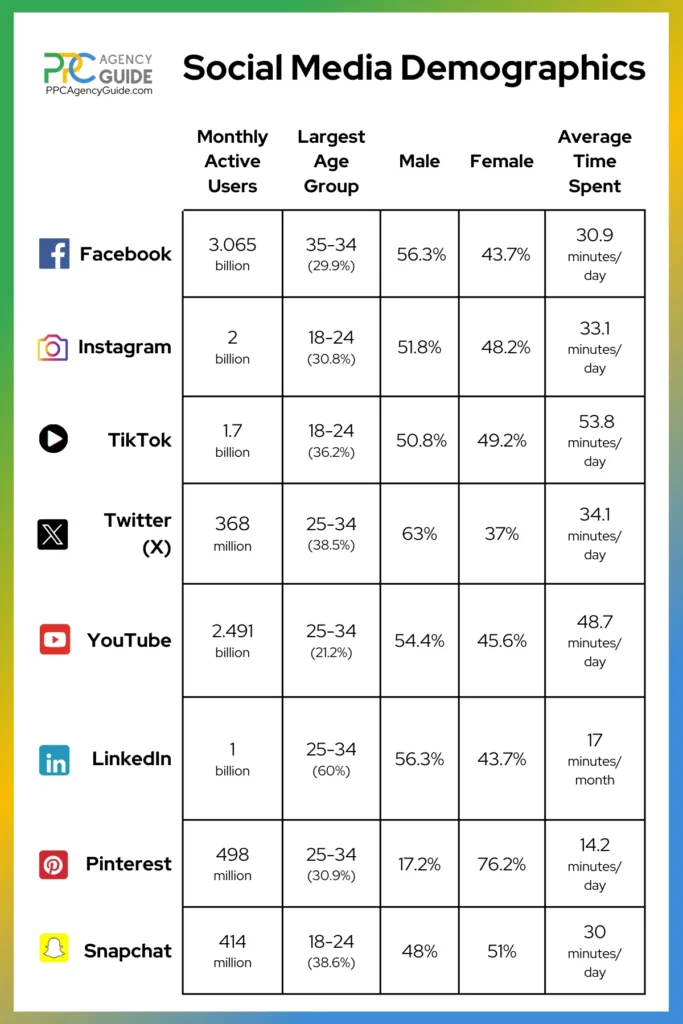
“Marketing is no longer about the stuff you make, but about the stories you tell.” While Seth Godin’s now-famous quote applies to virtually all aspects of marketing, it resonates a bit differently in the context of social media. It’s not just the products or services you offer but the narratives you weave around them that capture hearts and minds on platforms bustling with potential customers. However, success in this space isn’t about random posts or ads. It requires a strategic approach. On this page, we’ll explore social media advertising tips that can help you create strong connections with your audience and maximize your return on investment (ROI).
1. Leverage Platform-Specific Features for Targeted Reach
Each social media platform offers unique features to help advertisers reach their target audience more effectively. Understanding and utilizing these features can significantly enhance your advertising strategy, leading to better engagement rates and higher ROI.

- Facebook and Instagram: These platforms offer advanced targeting options based on user behavior, interests, and demographics. Learn how to optimize your campaigns with our detailed guide on Facebook Ads. Use Facebook’s Custom Audiences to retarget individuals who have previously interacted with your brand, or explore Lookalike Audiences to reach new users similar to your best customers.
- LinkedIn: Perfect for B2B companies, LinkedIn allows targeting by profession, job title, and industry. This makes it an invaluable tool for reaching decision-makers and professionals within specific sectors.
- Twitter (X): Use Twitter’s keyword targeting to reach users based on the tweets they interact with or hashtags they use. This can be particularly effective for timely campaigns or events.
- TikTok: With a younger demographic, TikTok offers unique opportunities for creative, visually engaging ads. Capitalize on its For You page algorithm by creating content that resonates with your target audience’s interests and behaviors. Consider utilizing mobile app ads to specifically target users on these platforms.
Tips for Maximizing Platform Features
Applying a few additional best practices can help you maximize the unique benefits of each platform.
- Always Keep Your Audience in Mind: When choosing a platform to advertise on, focus on where your target customers are most active and engaged. Understanding your audience’s preferences and behaviors will guide you in creating more impactful campaigns.
- Experiment with Different Ad Formats: Each platform offers a variety of ad formats, from Instagram stories to LinkedIn-sponsored content. Testing different formats can help you discover what resonates best with your audience and drives your campaign goals.
- Stay Updated on New Features and Changes: The digital landscape constantly changes, with social media platforms updating features and algorithms regularly. Keeping abreast of these updates allows you to adapt your strategies and maintain a competitive edge.
By tailoring your approach to each platform’s strengths and specific audience, you can maximize the impact of your social media advertising efforts. Remember, the key to successful advertising on social media isn’t just broad reach. It’s about making meaningful connections with your audience.
2. Create Creative Ads That Tell a Story
Connecting with your audience on social media is about more than just selling a product or service. It’s about telling a story that resonates with them. Ads that tell compelling stories are more likely to engage and leave a lasting impression.
- Focus on Emotion: Effective ad storytelling often involves tapping into emotions that drive your audience’s decisions. Emotionally charged ads can significantly increase engagement and recall, whether it’s happiness, nostalgia, or even fear of missing out (FOMO).
- Show, Don’t Tell: Use visuals and videos to show your audience what you want them to feel and understand. Visual storytelling can be more effective than text-heavy ads, especially on platforms like Instagram and TikTok, where visuals reign supreme. Videos can triple your ad clicks, too, Business Insider reports.
- Be Authentic: Authenticity resonates with social media users. Share real stories about your brand, customers, or employees to foster a genuine connection with your audience. Authenticity builds trust, and trust can lead to loyalty.
- Include a Clear Call-to-Action (CTA): Every story should have an end goal. Whether it’s visiting your website, signing up for a newsletter, or purchasing a product, your ad should clearly and concisely guide the audience to what to do next.
- Keep It Relatable: Your stories should reflect scenarios or emotions your target audience can relate to. Relatable content can help break down barriers between your brand and potential customers, making your message more effective.
By integrating these strategies into your social media ads, you’re engaging in a form of digital storytelling that can enhance your brand’s presence, deepen customer relationships, and drive meaningful actions. Remember, in the digital marketplace, the most memorable brands are those that connect with their audiences on a personal level through stories that echo their own experiences and aspirations.
3. Optimize Your Budget for Maximum Impact
Managing your social media advertising budget wisely ensures that every dollar spent contributes to achieving your marketing objectives. A well-planned budget not only prevents overspending but also maximizes the effectiveness of your campaigns.
- Set Clear Objectives: Begin by defining what success looks like for your campaigns. Whether it’s increasing brand awareness, driving traffic to your website, or generating leads, having clear goals helps you allocate your budget more effectively.
- Understand Platform Costs: Each social media platform has a unique ad cost structure, including different bidding options and formats. Familiarize yourself with these costs and factor them into your budgeting decisions.
- Allocate Budget Based on Performance: Continuously monitor the performance of your campaigns across platforms. Allocate more budget to the platforms and ad formats that deliver the best results in terms of engagement, leads, or sales.
- Use A/B Testing: Experiment with different ad creatives, targeting options, and ad placements. Use A/B testing to identify the most cost-effective strategies and refine your budget allocation based on these insights.
- Leverage Organic Posts: While paid advertising is essential, don’t overlook the value of organic content. Engaging organic posts can complement your paid ads and help stretch your budget further by building and maintaining audience engagement without additional costs.
By applying these budgeting techniques, you can ensure that your social media advertising efforts are efficient and effective, helping you achieve better ROI and maximize your investment.
4. Precision Target Your Audience to Boost Engagement
The ability to pinpoint your audience with precision is a game-changer. By targeting specific demographics, interests, and behaviors, you can ensure that your message reaches those most likely to engage with your brand.
- Understand Your Audience: Begin by diving deep into your audience data. Who are your current customers? What interests do they share? Social media platforms offer analytics tools that can provide valuable insights into your audience’s demographics, preferences, and online behaviors.
- Use the Right Channels: Facebook and Instagram tie when it comes to delivering top ROI, according to marketer surveys by HubSpot. However, that doesn’t mean that your audience leverages these platforms or that they’ll be receptive to your ads on them. Focus your efforts on platforms your audience uses to maximize your budget and boost ROI.
- Utilize Advanced Targeting Features: Platforms like Facebook and LinkedIn offer advanced targeting options that allow you to narrow down your audience by factors such as age, location, job title, and even recent purchase behavior. For example, Facebook’s Custom Audiences and Lookalike Audiences enable you to target users similar to your existing customers. At the same time, LinkedIn’s targeting can be invaluable for B2B marketers looking to reach professionals in specific industries.
- Incorporate Keywords and Hashtags: On platforms like Twitter (X) and Instagram, hashtags and keywords play a crucial role in reaching audiences interested in specific topics. Use relevant hashtags and keywords in your ads to increase visibility among users engaged in related conversations.
- Leverage Retargeting: Retargeting allows you to reach users who have previously interacted with your brand, whether they visited your website, liked a post on social media, or abandoned a shopping cart. This strategy helps keep your brand top-of-mind and encourages users to take the next step.
- Test and Refine: Testing is the only way to truly know what works. Run small-scale tests with different targeting criteria to see what yields the highest engagement. Use these insights to continually refine your targeting strategy over time.
By taking a targeted approach to your social media advertising, you can significantly increase the relevance of your ads, leading to higher engagement rates, improved conversion rates, and, ultimately, a better return on your advertising spend. Remember, the goal is to connect with your audience meaningfully, and precision targeting is the key to strengthening those connections.
5. Use Analytics to Measure and Optimize Campaign Success
Measuring the success of your social media advertising campaigns is crucial for understanding what’s working and what isn’t. Analytics provide the insights to optimize your strategy and ensure your advertising budget is spent effectively. Here’s how to make the most of analytics in your social media advertising efforts:
- Set Clear Goals: You must know what you’re measuring before diving into analytics. Set clear, measurable goals for each campaign, whether it’s increasing website traffic, boosting engagement, or generating leads. This will help you focus on the metrics that matter most.
- Understand Key Metrics: Familiarize yourself with the key metrics relevant to your goals. These can include engagement, click-through rates (CTR), conversion, and return on ad spend (ROAS). Each social media platform offers its own set of analytics tools that provide these metrics.
- Regularly Review Campaign Performance: Make it a habit to review the performance of your campaigns regularly. Social media platforms offer real-time analytics, allowing you to monitor the effectiveness of your ads and make adjustments as needed. Pay attention to trends over time, as they can provide valuable insights into what content resonates with your audience.
- Segment Your Data: Look at your analytics data in segments to better understand how different audiences respond to your ads. This might include segmenting by demographic information, geographic location, or even the type of content. This granular view can help you effectively tailor your campaigns to different audience segments.
- Test and Learn: Use analytics as a tool for continuous learning. Experiment with different ad formats, messaging, and targeting options, then use analytics to evaluate their performance. A/B testing can be particularly effective in identifying what changes lead to better results.
- Act on Insights: The most crucial step is to use the insights gained from analytics to inform future strategies. If certain types of content consistently perform well, consider focusing more on those. If some ads have a low ROI, it may be time to reevaluate your approach for those campaigns.
By leveraging analytics to measure and optimize your social media advertising campaigns, you can improve your strategy over time and ensure that your advertising efforts lead to meaningful business outcomes. Remember, the goal of analytics is not just to collect data but to derive actionable insights that drive better decision-making and campaign performance.
6. Create Engaging Content That Resonates
Social media thrives on content that engages and resonates with its audience. But creating content that strikes a chord requires a blend of creativity, strategy, and insight into what your audience truly values.
- Deepen Audience Understanding: Use analytics and direct feedback to gain insights into your audience’s preferences, behaviors, and engagement patterns. This deeper understanding will guide you in creating content that truly engages them.
- Highlight Authenticity: Authentic connections are formed when your audience sees the real stories behind your brand. Share your brand’s journey, the people who power it, and what makes you unique. Authenticity builds trust and encourages loyalty, making it vital for sustaining engagement.
- Leverage Visual Content: Visuals — from images and videos to infographics — are crucial to capturing attention on social media. They’re not just shareable but memorable, too. While platforms like Instagram and TikTok are inherently visual, the impact of compelling visuals extends across all platforms, including LinkedIn and Twitter (X).
- Encourage Interaction: Boost engagement by inviting your audience to interact with your content. Things like polls, questions, or calls to action enhance engagement metrics and offer valuable insights into your audience’s preferences.
- Customize Content for Each Platform: Tailor your content to suit each platform’s unique environment. For instance, Instagram’s casual tone and visual nature differ from LinkedIn’s professional vibe. Adapting your message and style ensures your content resonates with the platform’s audience.
- Stay Agile with Trends and Feedback: Keep your content strategy fresh and relevant by staying on top of industry and social media trends. Use engagement metrics and audience feedback to refine your approach continually. Agility in responding to trends and feedback keeps your content strategy aligned with audience interests and preferences.
Creating engaging content is an ongoing process that blends creative storytelling with strategic insights. By focusing on authenticity, interactivity, and tailored content, you can cultivate a vibrant community around your brand and foster lasting connections on social media.
7. Experiment with Diverse Ad Formats to Increase Engagement
The digital landscape of social media is rich with various ad formats, each offering unique ways to captivate your audience. Experimenting with these formats can uncover what truly resonates with your audience, leading to increased engagement and better campaign results.

- Explore Video Ads: Videos are incredibly engaging and can convey your message in a dynamic way that text and images alone cannot match. Platforms like Facebook, Instagram, and TikTok offer extensive options for video ads, including short-form videos, stories, and live streams.
- Utilize Carousel Ads: Carousel ads allow you to showcase multiple images or videos in a single ad, each with its own link. This format is perfect for highlighting a product’s different features, telling a step-by-step story, or sharing a collection that captures your brand essence.
- Incorporate Stories Ads: Stories ads are full-screen, immersive ads that appear between users’ stories on Instagram, Facebook, and Snapchat. They offer a great way to grab attention in a more personal and engaging format.
- Try Interactive Ads: Interactive ads, such as polls, quizzes, and augmented reality (AR) experiences, invite users to engage directly with your content. This boosts engagement rates and increases the likelihood of your ad being remembered and shared.
- Consider Sponsored Content: Sponsored content on platforms like LinkedIn allows you to place your brand directly in the professional content feed of your target audience, presenting your message in a contextually relevant manner.
- Monitor and Adapt: Keep a close eye on the performance of different ad formats through analytics. Note which formats drive the most engagement, highest conversion rates, or best overall ROI, and adapt your strategy accordingly.
Diversifying your social media ad formats keeps your content fresh and engaging and allows you to explore creative ways to connect with your audience. Remember, the goal is not just to reach your audience but to resonate with them in a way that leaves a lasting impression.
8. Build a Community Around Your Brand
Creating a strong community around your brand on social media fosters an environment where your audience feels connected and engaged with your mission, values, and stories. This can provide the social proof people look for while viewing your ads and boost their effectiveness.
- Engage Regularly and Authentically: Consistent engagement with your audience is vital to building a community. Respond to comments, messages, and posts. Your responsiveness shows that you value your audience’s input and are interested in building relationships with them.
- Create Shareable Content: Make your content relatable, valuable, and aligned with your followers’ interests to encourage them to share it. Shareable content extends your reach organically and introduces your brand to potential new community members.
- Highlight User-Generated Content: Showcasing content created by your audience, such as reviews, testimonials, or creative uses of your product, can foster a sense of belonging and pride among your community members. It also provides authentic social proof for your brand.
- Host Live Sessions and Q&As: Use live video sessions, webinars, or Q&A sessions to interact with your community in real-time. This direct interaction can strengthen the connection between your brand and its followers, giving them a platform to voice their opinions and questions.
- Create Exclusive Groups or Forums: Consider creating private groups or forums for your brand on platforms like Facebook or LinkedIn. These can be spaces for deeper discussion, exclusive content, and fostering peer-to-peer support among members.
- Celebrate Milestones Together: Share your brand’s achievements and milestones with your community, and thank them for their role in your success. Celebrating together can enhance the community feeling and reinforce their importance to your brand.
Building a community around your brand is about nurturing relationships that go beyond the transactional. It’s about creating a space where your audience feels valued, heard, and connected. A strong community supports your current advertising efforts and lays the foundation for long-term brand loyalty and advocacy.
9. Stay Ahead by Keeping Up with Social Media Trends
Staying informed about the latest trends in social media is crucial for ensuring your advertising strategies remain effective and engaging. Social media platforms evolve rapidly, introducing new features, algorithms, and user preferences that can impact the success of your ads.
- Follow Industry Leaders and Influencers: These people often have early insights into emerging trends and changes in social media. Following them can give you valuable foresight into what’s next and how to prepare your brand for these changes.
- Utilize Platform Insights: Social media platforms frequently publish reports and insights on user behavior and emerging trends. These can be goldmines of information for advertisers looking to stay ahead of the curve.
- Attend Webinars and Conferences: Digital marketing and social media conferences and webinars are great places to learn about the latest trends and network with other professionals. These events can offer insights into new strategies and tools to benefit your campaigns.
- Experiment with New Features: When social media platforms launch new features, they often promote content that uses them. Being an early adopter can boost your content engagement and differentiate your brand from competitors.
- Listen to Your Audience: Your audience’s behavior and feedback can be indicative of broader trends. Pay attention to the content they engage with the most, and don’t be afraid to ask them directly what they’d like to see more of.
- Analyze Competitor Strategies: Monitoring your competitors can offer insights into what’s working in your industry. While you shouldn’t copy their strategies outright, understanding their approaches can inspire your own innovations.
By staying informed and adaptable, you can ensure your social media advertising remains relevant and compelling, even as trends shift. This proactive approach helps you maintain engagement with your current audience and attracts new followers looking for brands that understand and reflect their interests and needs.
10. Enhance Your Reach with Influencer Partnerships
Partnering with influencers can significantly amplify your social media advertising efforts. Influencers have established trust and rapport with their followers, making their endorsements a powerful tool for brands looking to expand their reach and credibility.
- Identify the Right Influencers: Look for influencers who align with your brand values and have an audience that matches your target demographic. Authenticity in the partnership is vital to its success.
- Focus on Micro-Influencers: While mega-influencers have vast followings, micro-influencers often boast higher engagement rates. Their audiences are typically more niche and dedicated, leading to potentially higher-impact collaborations.
- Establish Clear Collaboration Goals: Whether it’s increasing brand awareness, launching a new product, or driving sales, having clear objectives for your influencer partnership helps ensure both parties are aligned and can measure success effectively.
- Encourage Creative Freedom: Influencers know their audience best. Allowing them creative freedom in presenting your brand can result in more authentic and engaging content.
- Measure and Analyze Performance: Use tracking links, promo codes, and social media analytics to measure the performance of influencer collaborations. This data will help you understand the ROI of your influencer partnerships and how they can be optimized.
- Build Long-Term Relationships: Consider building long-term relationships with influencers rather than one-off campaigns. Consistent collaborations can lead to stronger brand affiliation and loyalty from the influencer and their audience.
Influencer partnerships offer a unique opportunity to humanize your brand and introduce it to new audiences in a relatable way. You can significantly boost your social media advertising effectiveness by carefully selecting influencers who resonate with your target audience and fostering genuine collaborations.
Get Help Implementing These Social Media Advertising Tips
Throughout this guide, we’ve explored key strategies to enhance your social media advertising efforts, from leveraging platform-specific features and creating engaging content to staying ahead with the latest trends. Each tip offers a pathway to reach your audience more effectively and build lasting connections that drive results. If you want help implementing these tips or ensuring your advertising campaigns are as effective as possible, we’re happy to connect you with an experienced PPC agency. Request a complimentary consultation to get started.


















